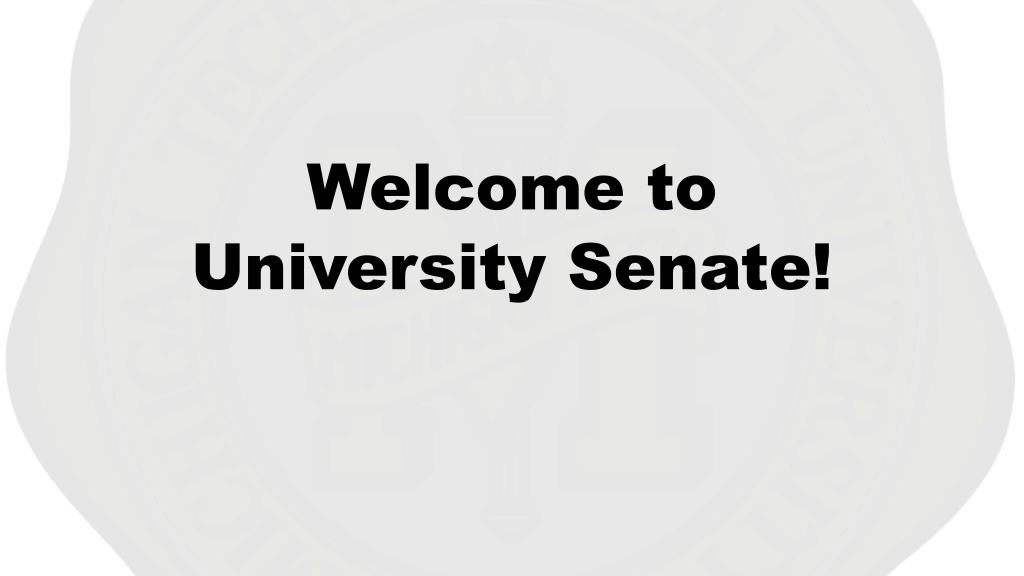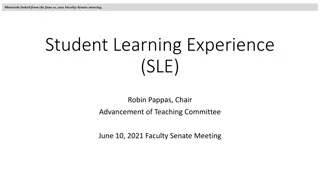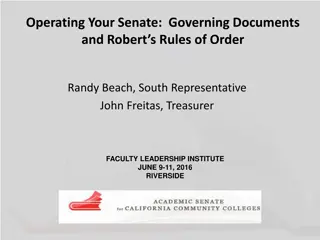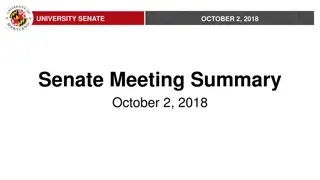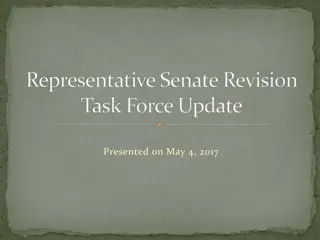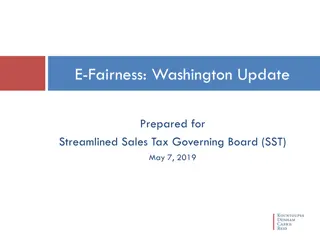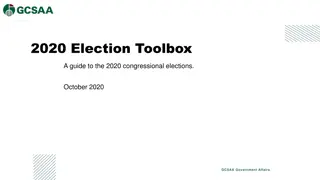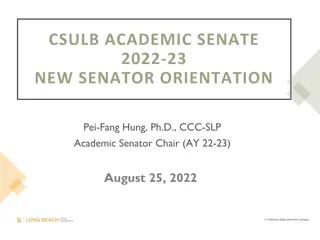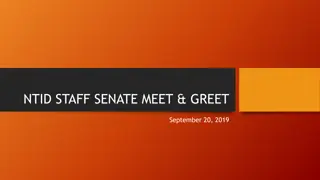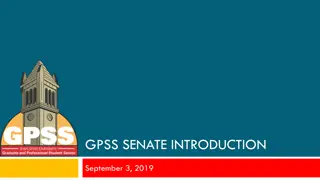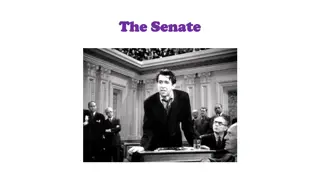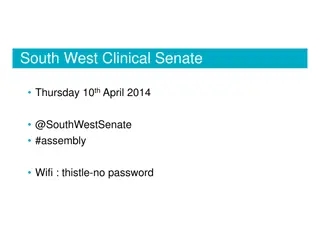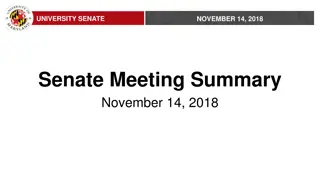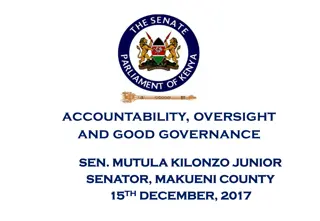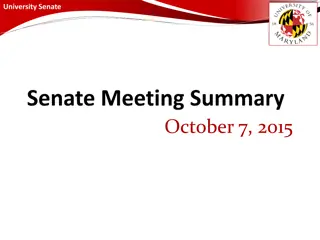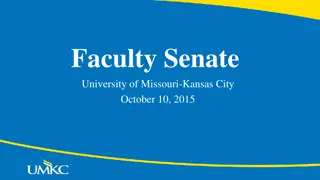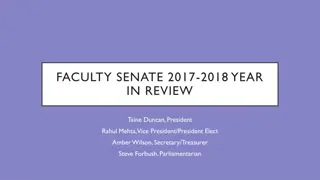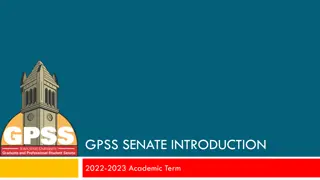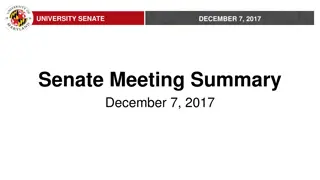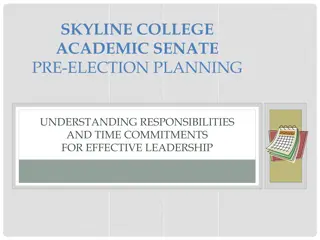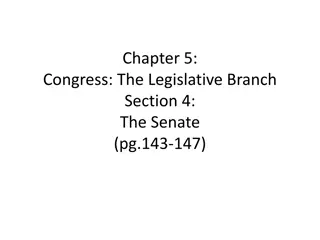University Senate - Vision, Role, and Responsibilities
The University Senate plays a crucial role in promoting faculty and staff interests, overseeing academic quality, and supporting ethical behavior within the university community. Through its legislative authority, it ensures student learning, academic freedom, and the protection of faculty rights. This governing body addresses a wide range of curricular matters, academic policies, and faculty issues, impacting various aspects of university life.
Download Presentation

Please find below an Image/Link to download the presentation.
The content on the website is provided AS IS for your information and personal use only. It may not be sold, licensed, or shared on other websites without obtaining consent from the author.If you encounter any issues during the download, it is possible that the publisher has removed the file from their server.
You are allowed to download the files provided on this website for personal or commercial use, subject to the condition that they are used lawfully. All files are the property of their respective owners.
The content on the website is provided AS IS for your information and personal use only. It may not be sold, licensed, or shared on other websites without obtaining consent from the author.
E N D
Presentation Transcript
Welcome to University Senate!
Just Another Thursday About once a month, on scores of college and university campuses around the United States, dozens or hundreds of people mill into the auditorium, resigned to the fact that it s going to be a while. There is gavel-pounding. There is heated debate over comma vs. semicolon usage in biology department literature. The institution s president is barraged with questions. And, yes, there are PowerPoint presentations. - J.B. Jones, Chronicle of Higher Education, Sept. 2011
University Senate Vision The University Senate will be regarded as a respected, relevant and independent representative body that leads by promoting faculty and staff interests in the shared governance of the University. Its actions support the University mission and the day- to-day professional activities of faculty and staff. The University Senate is an active partner in University decisions affecting academic and administrative affairs.
Role in Supporting this Vision Provide oversight of academic quality by promoting a rigorous and relevant curriculum with attractive and innovative degree programs that best serve students and society Serve as the legislative authority for academic policies and educational guidelines that encourage and ensure student learning Promote ethical behavior, professional discourse, and mutual respect among all members of the University community Ensure that academic freedom and tenure is encouraged and protected in all forms Provide a source of advice and support for the University administration and Board of Trustees by making recommendations regarding faculty and professional staff issues, University finances, compensation, and the workplace environment
A-List Items All curricular matters, including establishment, dissolution, and changes in degree programs Requirements for certificates and academic degrees Regulations regarding attendance, examinations, grading, scholastic standing, probation, and honors Teaching quality and the evaluation of teaching The appointment, promotion, tenure, dismissal, and leaves of academic faculty Criteria for positions that are to be accorded academic rank Regulations concerning the awarding of honorary degrees Requirements and criteria for unit charters for each academic department Other areas under authority as may be granted by the Board of Trustees, the University President, or their designated representative
B-List Examples Fringe benefits Prioritization of the university's human, fiscal, and physical resources The Van Pelt Library, computing facilities, audiovisual support, Lauren Bookstore, A.E. Seaman Mineral Museum, et cetera as they affect scholarly, instructional, and research activities Admission standards and procedures Student financial aid Selection and review of the University President, the Provost, and other upper administrators Administrative procedures and organizational structure
University Senate Functions Take action in our role as the chief advocate for faculty and professional staff, and use our granted authority on academic policy and shared governance matters Provide faculty and professional staff feedback to the administration, university committees, and the Board of Trustees when requested Inform our constituents about current university activities, plans, and policy changes There are three main categories of meeting agenda items: Reports Informational items - memos Action items - proposals
Agenda Items Reports may be provided by the president and/or committee chairs as needed Information items are points of business not requiring action Action items (proposals) require approval and are discussed and debated over two meetings
Action Items (Continued) Listed under New Business at the first meeting, background on the topic is provided and initial discussion occurs. Debate is not necessary, but senators seek feedback from their constituents The proposal returns as Old Business with motion to accept, followed by debate, and one of the following actions: Voted up or down Send back to committee for revision and resubmission Modified via amendments, which are handled separately prior to the vote on the original motion Time extension, tabling, or referral to committee if necessary
Rules of Order Familiarize yourself with Robert s Rules of Order Cheat sheet provided on Senate website, copy in senate office Voting on motions Unanimous consent Acclamation most typical Roll-call Ballot takes precedence over all others Debate moderated by the chair Only senators speak, when called on by the chair Senators are limited to one comment and one retort per discussion Legitimate interruptions to the debate process: Point of order question of procedure to the chair Point of information question of expertise to another senator or visitor Point of inquiry request for clarification on a proposal *Point of personal privilege addressing personal comfort/safety (rare)*
General Productivity Come prepared and engage in the process Read materials in advance and prepare questions Provide feedback to committees before meetings Have questions ready Bring alternative views/perspectives to debate Focus on issues, not individuals Act in good faith and assume others are doing the same Value everyone s time
